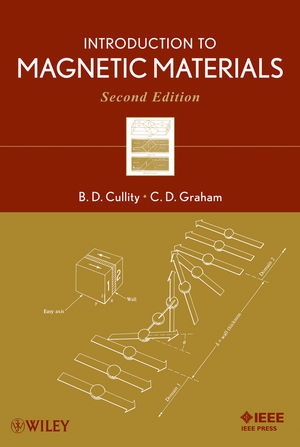Introduction to Magnetic Materials, 2nd EditionISBN: 978-0-471-47741-9
Hardcover
568 pages
December 2008, Wiley-IEEE Press
 This is a Print-on-Demand title. It will be printed specifically to fill your order. Please allow an additional 15-20 days delivery time. The book is not returnable.
|
||||||
Preface to the Second Edition.
1. Definitions and Units.
1.1 Introduction.
1.2 The cgs-emu System of Units.
1.3 Magnetic Moment.
1.4 Intensity of Magnetization.
1.5 Magnetic Dipoles.
1.6 Magnetic Effects of Currents.
1.7 Magnetic Materials.
1.8 SI Units.
1.9 Magnetization Curves and Hysteresis Loops.
2. Experimental Methods.
2.1 Introduction.
2.2 Field Production By Solenoids.
2.3 Field Production by Electromagnets.
2.4 Field Production by Permanent Magnets.
2.5 Measurement of Field Strength.
2.6 Magnetic Measurements in Closed Circuits.
2.7 Demagnetizing Fields.
2.8 Magnetic Shielding.
2.9 Demagnetizing Factors.
2.10 Magnetic Measurements in Open Circuits.
2.11 Instruments for Measuring Magnetization.
2.12 Magnetic Circuits and Permeameters.
2.13 Susceptibility Measurements.
Problems.
3. Diamagnetism and Paramagnetism.
3.1 Introduction.
3.2 Magnetic Moments of Electrons.
3.3 Magnetic Moments of Atoms.
3.4 Theory of Diamagnetism.
3.5 Diagmagnetic Substances.
3.6 Classical Theory of Paramagnetism.
3.7 Quantum Theory of Paramagnetism.
3.8 Paramagnetic Substances.
Problems
4. Ferromagnetism.
4.1 Introduction.
4.2 Molecular Field Theory.
4.3 Exchange Forces.
4.4 Band Theory.
4.5 Ferromagnetic Alloys.
4.6 Thermal Effects.
4.7 Theories of Ferromagnetism.
4.8 Magnetic Analysis.
Problems.
5. Antiferromagnetism.
5.1 Introduction.
5.2 Molecular Field Theory.
5.3 Neutron Diffraction.
5.4 Rare Earths.
5.5 Antiferromagnetic Alloys.
Problems.
6. Ferrimagnetism.
6.1 Introduction.
6.2 Structure of Cubic Ferrites.
6.3 Saturation Magnetization.
6.4 Molecular Field Theory.
6.5 Hexagonal Ferrites.
6.6 Other Ferrimagnetic Substances.
6.7 Summary: Kinds of Magnetism.
Problems.
7. Magnetic Anisotropy.
7.1 Introduction.
7.2 Anisotropy in Cubic Crystals.
7.3 Anisotropy in Hexagonal Crystals.
7.4 Physical Origin of Crystal Anisotropy.
7.5 Anisotropy Measurement.
7.6 Anisotropy Measurement (from Magnetization Curves).
7.7 Anisotropy Constants.
7.8 Polycrystalline materials.
7.9 Anisotropy in Antiferromagnetics.
7.10 Shape Anisotropy.
7.11 Mixed Anisotrophies.
Problems.
8. Magnetostriction and the Effects of Stress.
8.1 Introduction.
8.2 Magnetostriction of Single Crystals.
8.3 Magnetostriction of Polycrystals.
8.4 Physical Origin of Magnetostriction.
8.5 Effect of Stress on Magnetic Properties.
8.6 Effect of Stress on Magnetostriction.
8.7 Applications of Magnetostriction.
8.8 ΔE Effect.
8.9 Magnetoresistance.
Problems.
9. Domains and the Magnetization Process.
9.1 Introduction.
9.2 Domain Wall Structure.
9.3 Domain Wall Observation.
9.4 Magnetostatic Energy and Domain Structure.
9.5 Single-Domain Particles.
9.6 Micromagnetics.
9.7 Domain Wall Motion.
9.8 Hindrances to Wall Motion (Inclusions).
9.9 Residual Stress.
9.10 Hindrances to Wall Motion (Microstress).
9.11 Hindrances to Wall Motion (General).
9.12 Magnetization by Rotation.
9.13 Magnetization in Low Fields.
9.14 Magnetization in High Fields.
9.15 Shapes of Hysteresis Loops.
9.16 Effect of Plastic Deformation (Cold Work).
Problems.
10. Induced Magnetic Anisotropy.
10.1 Introduction.
10.2 Magnetic Annealing (Substitutional Solid Solutions).
10.3 Magnetic Annealing (Interstitial Solid Solutions).
10.4 Stress Annealing.
10.5 Plastic Deformation (Alloys).
10.6 Plastic Deformation (Pure Metals).
10.7 Magnetic Irradiation.
10.8 Summary of Anisotropies.
11. Fine Particles and Thin Films.
11.1 Introduction.
11.2 Single-Domain vs Multi-Domain Behavior.
11.3 Coercivity of Fine Particles.
11.4 Magnetization Reversal by Spin Rotation.
11.5 Magnetization Reversal by Wall Motion.
11.6 Superparamagnetism in Fine particles.
11.7 Superparamagnetism in Alloys.
11.8 Exchange Anisotropy.
11.9 Preparation and Structure of Thin Films.
11.10 Induced Anisotropy in Films.
11.11 Domain Walls in Films.
11.12 Domains in Films.
Problems.
12. Magnetization Dynamics.
12.1 Introduction.
12.2 Eddy Currents.
12.3 Domain Wall Velocity.
12.4 Switching in Thin Films.
12.5 Time Effects.
12.6 Magnetic Damping.
12.7 Magnetic Resonance.
Problems.
13. Soft Magnetic Materials.
13.1 Introduction.
13.2 Eddy Currents.
13.3 Losses in Electrical Machines.
13.4 Electrical Steel.
13.5 Special Alloys.
13.6 Soft Ferrites.
Problems.
14. Hard Magnetic Materials.
14.1 Introduction.
14.2 Operation of Permanent Magnets.
14.3 Magnet Steels.
14.4 Alnico.
14.5 Barium and Strontium Ferrite.
14.6 Rare Earth Magnets.
14.7 Exchange-Spring Magnets.
14.8 Nitride Magnets.
14.9 Ductile Permanent Magnets.
14.10 Artificial Single Domain Particle.
14.11 Bonded Magnets.
14.12 Magnet Stability.
14.13 Summary of Magnetically Hard Materials.
14.14 Applications.
Problems.
15. Magnetic Materials for Recording and Computers.
15.1 Introduction.
15.2 Magnetic Recording.
15.3 Principles of Magnetic Recording.
15.4 Magnetic Digital Recording.
15.5 Perpendicular Recording.
15.6 Possible Future Developments.
15.7 Magneto-Optic Recording.
15.8 Magnetic Memory.
16. Magnetic Properties of Superconductors.
16.1 Introduction.
16.2 Type I Superconductors.
16.3 Type II Superconductors.
16.4 Susceptibility Measurements.
16.5 Demagnetizing Effects.
Appendix 1. Dipole Fields and Energies.
Appendix 2. Data on Ferromagnetic Elements.
Appendix 3. Conversion of Units.
Appendix 4. Physical Constants.
Index.



